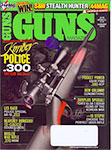
Featherweight Magic
Kahr’s new P380 pistol.
Guns Magazine, August 2009, p. 30 - 31 By Massad Ayoob
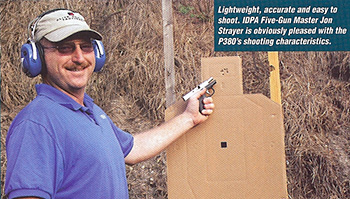 Lightweight, accurate and easy to shoot. IDPA Five-Gun Master Jon Strayer is obviously pleased with the P380’s shooting characteristics.
Lightweight, accurate and easy to shoot. IDPA Five-Gun Master Jon Strayer is obviously pleased with the P380’s shooting characteristics.
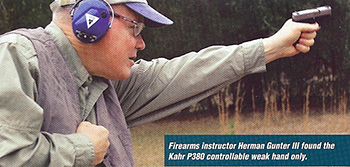 Firearms instructor Herman Gunter III found the Kahr P380 controllable weak hand only.
Firearms instructor Herman Gunter III found the Kahr P380 controllable weak hand only.
Ultra-thin, ultra-light (under 10 ounces being the new weight class) .380 pistols are taking the market by storm, setting records for the number of orders by dealers, and back-orders at the factories. Each has thus far been purpose-built for the minimum size/weight envelope with the .380 ACP cartridge. At Kahr Arms, Justin Moon took a different approach, by scaling down his pistol developed for the 9x19mm cartridge and proven for 15 years since, to work with the 9x17mm .380 cartridge.
Shooting a prototype for the first time in second quarter 2008 in Tennessee, I was struck by how easy it was to hit with this tiny pistol. The sights are the same big-enough-to-see, “dot the i,” dovetailed front and back fixed units you get on regular Kahrs, and yes, for more bucks, you can get tritium night sights in a 3-dot pattern. Yes, it has the same smooth, straight-through double action trigger pull (which averaged just under six pounds on our test sample) that has made Kahr famous. No, it doesn’t have double strike capability, but most folks figure if their gun goes “click” instead of “bang,” they’re gonna do a tap-rack drill and get a fresh cartridge into the chamber anyway.
The P380 comes in barely under the 10-ounce weight limit for its class (unloaded) and is well under 1” in thickness. Its payload is the standard-for-its-category six rounds in the magazine and one more in the launch tube. The internal firing pin lock design makes 6+1 carry safe so long as the triggerguard is covered by a holster, which for this gun will probably be a pocket holster.
Short Reach
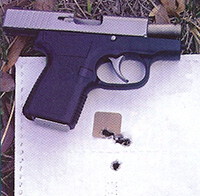 Shooting six headshots at 7 yards, PPC pace proved the Kahr P380 is “shootable.”
Shooting six headshots at 7 yards, PPC pace proved the Kahr P380 is “shootable.”
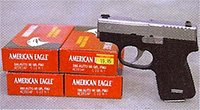 When Kahr says it needs a 200-round break-in, they mean it. But it does work and the pistol became very reliable afterward.
When Kahr says it needs a 200-round break-in, they mean it. But it does work and the pistol became very reliable afterward.
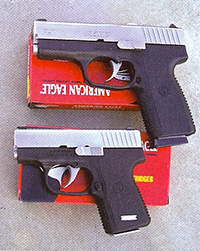 The 9mm Kahr P9 (top), almost dwarfs its 10-ounce little brother .380 (bottom).
The 9mm Kahr P9 (top), almost dwarfs its 10-ounce little brother .380 (bottom).The trigger reach is so short it will be ideal for petite females and other folks with very short fingers, and the rest of us will have to learn to adapt. I found I had to cock my index finger a little outboard to keep from going too deep in the triggerguard, and to find that sweet spot the old double-action revolver masters sometimes called “the power crease.” This is the distal joint of the trigger finger, on the palm side. With your thumbs curled down, they’ll block all but the shortest trigger finger. With this tiny Kahr, you learn to shoot with your thumbs pointed downrange and out to the side, where they won’t (in right handed shooting) impinge on the slide stop/slide lock lever. Note, however, if you have very long thumbs, they may extended past the muzzle, which is a bad thing when the gun goes off. In that case, you need the thumbs-toward-the sky position my colleague John Farnam teachers with all handguns.
What’s cool about the Kahr .380 is you can hit with the darn thing. We all know .380 teeters on the very bottom edge of an “acceptable to professionals” power level. That places a premium on deliverable accuracy, to put the bullets into vital zones on hard-to-hit targets ... which, in turn, plus a premium on the nebulous factor we call “shootability.”
Accurate
With a production line test sample of the Kahr P380, I was able to empty a 6-round magazine of 95-grain FMJ at a police qualification pace into a 1.15” group, with five of the six shots in one ragged cluster measuring 3/4” apart, center to center. At 25 yards, the test P380 off a bench rest delivered a 3” 5-shot group, with four of those shots in 2.10” and the best three in an amazing 1” even. The ammunition was Hornady 90-grain XTP, designed to open up some and still give deep penetration, a combination difficult to achieve with the .380 cartridge. (Hornady’s new Critical Defense load, with what might be called an “expander” in its hollow nose, has reportedly shown great promise in ballistic gelatin testing, but it’s too new to have any track record for actual shootings, and I didn’t have any on hand to test.) Fiocchi 90-grain full metal jacket was also astoundingly accurate for a gun of this size, putting five shots into 3.15” at 25 yards off the bench, with four of the five in 1.20” and the best three in a cloverleaf measuring .35” center-to-center and raised my eyebrows significantly. Some other ammo gave bigger groups. Still, this is by far the most consistently accurate “mini” .380 I’ve shot yet.
Downside? There is no polymer frame .380 in the 10-ounce weight class I’d trust to be reliable out of the box before hundreds of rounds of testing. Kel-Tec had to tweak their P3AT, Ruger had to call back and tweak their hugely popular LCP and I discovered when Kahr says you need to put 200 rounds through their guns before you start to trust them, they mean it! In our first 200. we had failures to feed, failures to go into battery, and failures to both extract and eject. However, the combination of the break-in regimen with cleaning (Kahrs are well known for having tight chambers) and ample lubrication got the P380 to peak 100 percent at last. Recoil was soft, and the break-in was fun, if necessarily expensive.
At $649 retail, this little Kahr .380 is about twice as costly as a Kel-Tec or Ruger in the same size/weight class, but I also found it roughly twice as “shootable,” which makes it a fair value. If there was a national championship of sub-10-ounce .380 shooting, the Kahr P380 is the pistol I’d bring to the match. Nothing else like it comes with sights, trigger and hit potential this good, not to mention the P380 is the only gun in its class that locks that slide back when it runs dry, and closes that slide with a simple downward press of a lever, allowing the fastest possible reloads. There isn't such a national championship, but there might be a contest where a fast central nervous system hit with a .380 bullet might decide some much greater stakes, and with a 10-ounce polymer micro pistol, I’d still stake such a gamble on the Kahr P380.
<< Go back to Previous Page